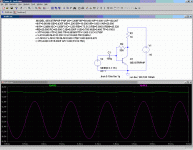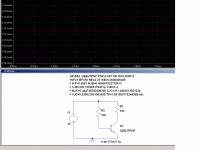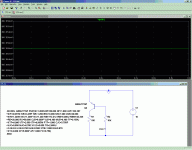.model 2N344 PNP(Is=1e-10 bf=11 Vaf=15 Cje=5p Cjc=2.5p Tf=3n
+ Eg=.67 Rb=100 Re=10)
I found this in a thread here!
+ Eg=.67 Rb=100 Re=10)
I found this in a thread here!
in this case this thread could be of interest:
http://www.diyaudio.com/forums/soli...ling-how-do-i-generate-p-spice-parameter.html
http://www.diyaudio.com/forums/soli...ling-how-do-i-generate-p-spice-parameter.html
I found some more accurate parameters at DIY Stompboxes...
.MODEL AC128 PNP IS=1f IB=4-e4 ISC=1-e6 IKF=20m ITF=0.4
+NC=3 NE=2.5 BF=70 BR=5 RC=10 RB=50 RE=1 CJC=50p CJE=10p
+TR=20u TF=1u FC=0.5 EG=0.67 VAF=60 VJC=0.28 VJE=0.28 VTF=4
+MJC=0.4 MJE=0.4 XTB=2.0 XTF=6 XTI=3.5
.END
.MODEL AC128 PNP IS=1f IB=4-e4 ISC=1-e6 IKF=20m ITF=0.4
+NC=3 NE=2.5 BF=70 BR=5 RC=10 RB=50 RE=1 CJC=50p CJE=10p
+TR=20u TF=1u FC=0.5 EG=0.67 VAF=60 VJC=0.28 VJE=0.28 VTF=4
+MJC=0.4 MJE=0.4 XTB=2.0 XTF=6 XTI=3.5
.END
IB and ISC parameter corrections.l..
.MODEL AC128 PNP IS=1f IB=400u ISC=100u IKF=20m ITF=0.4
+NC=3 NE=2.5 BF=70 BR=5 RC=10 RB=50 RE=1 CJC=50p CJE=10p
+TR=20u TF=1u FC=0.5 EG=0.67 VAF=60 VJC=0.28 VJE=0.28 VTF=4
+MJC=0.4 MJE=0.4 XTB=2.0 XTF=6 XTI=3.5
.END
.MODEL AC128 PNP IS=1f IB=400u ISC=100u IKF=20m ITF=0.4
+NC=3 NE=2.5 BF=70 BR=5 RC=10 RB=50 RE=1 CJC=50p CJE=10p
+TR=20u TF=1u FC=0.5 EG=0.67 VAF=60 VJC=0.28 VJE=0.28 VTF=4
+MJC=0.4 MJE=0.4 XTB=2.0 XTF=6 XTI=3.5
.END
MORE ACCURATE MODELS OF NPN AND PNP GERMANIUM TRANSISTORS:
.MODEL AC127 NPN IS=1f IB=400u ISC=1u IKF=20m ITF=0.4
+NC=3 NE=2.5 BF=70 BR=5 RC=10 RB=50 RE=1 CJC=50p CJE=10p
+TR=8u TF=400n FC=0.5 EG=0.67 VAF=60 VJC=0.28 VJE=0.28 VTF=4
+MJC=0.4 MJE=0.4 XTB=2.0 XTF=6 XTI=3.5
.END
.MODEL AC128 PNP IS=1f IB=400u ISC=1u IKF=20m ITF=0.4
+NC=3 NE=2.5 BF=70 BR=5 RC=10 RB=50 RE=1 CJC=50p CJE=10p
+TR=20u TF=1u FC=0.5 EG=0.67 VAF=60 VJC=0.28 VJE=0.28 VTF=4
+MJC=0.4 MJE=0.4 XTB=2.0 XTF=6 XTI=3.5
.END
Using the parameters I found earlier and looking at a typical datasheet I put these two models together. They are generically similar, with the exception of frequency response.
.MODEL AC127 NPN IS=1f IB=400u ISC=1u IKF=20m ITF=0.4
+NC=3 NE=2.5 BF=70 BR=5 RC=10 RB=50 RE=1 CJC=50p CJE=10p
+TR=8u TF=400n FC=0.5 EG=0.67 VAF=60 VJC=0.28 VJE=0.28 VTF=4
+MJC=0.4 MJE=0.4 XTB=2.0 XTF=6 XTI=3.5
.END
.MODEL AC128 PNP IS=1f IB=400u ISC=1u IKF=20m ITF=0.4
+NC=3 NE=2.5 BF=70 BR=5 RC=10 RB=50 RE=1 CJC=50p CJE=10p
+TR=20u TF=1u FC=0.5 EG=0.67 VAF=60 VJC=0.28 VJE=0.28 VTF=4
+MJC=0.4 MJE=0.4 XTB=2.0 XTF=6 XTI=3.5
.END
Using the parameters I found earlier and looking at a typical datasheet I put these two models together. They are generically similar, with the exception of frequency response.
Sorry, but they look suspicious: I just made a quick test and found they had a Vbe of ~0.7V when biased properly......
I analyzed some of the info on a Germanium PNP NTK275 and modified a Subcircuit with these parameters...I think this is a bit more accurate than the AC127-128 I started with.
The elusiveness of various characteristics of the Antique Germanium Xstr in SPICE is quite perplexing...Gain, Frequency Response, Current Leakage and Energy Gap most notably.
GENERIC GERMANIUM TRANSISTOR SPICE MODEL PARAMETERS:
Bf=50 Br=5 Is=1f Ikf=20m Xti=3.5 Xtb=2.0
VAF=60 Nc=3 Ne=2.5 Isc=1u Eg=0.67 Vjc=0.28 Vje=0.28
Rc=10 Rb=50 Re=1 Cjc=50p Cje=10p Mjc=0.4 Mje=0.4
Tf=1u Tr=20u Itf=0.4 Vtf=4 Xtf=6
The elusiveness of various characteristics of the Antique Germanium Xstr in SPICE is quite perplexing...Gain, Frequency Response, Current Leakage and Energy Gap most notably.
GENERIC GERMANIUM TRANSISTOR SPICE MODEL PARAMETERS:
Bf=50 Br=5 Is=1f Ikf=20m Xti=3.5 Xtb=2.0
VAF=60 Nc=3 Ne=2.5 Isc=1u Eg=0.67 Vjc=0.28 Vje=0.28
Rc=10 Rb=50 Re=1 Cjc=50p Cje=10p Mjc=0.4 Mje=0.4
Tf=1u Tr=20u Itf=0.4 Vtf=4 Xtf=6
*GEXSTRPNP BJT PNP Germanium Transistor SPICE Model
*
.MODEL GEXSTRPNP PNP (IS=1.208F BF=50.000 NF=1.000 VAF=102.207
+IKF=9.981M ISE=0.435F NE=1.200 BR=10.000 NR=1.000 VAR=20.000
+IKR=1.248M ISC=1.208F NC=1.200 RB=173.312 IRB=5.000U RBM=43.328
+RE=20.000 RC=60.000 CJE=6.000P VJE=0.700 MJE=0.400 TF=0.150U
+ XTF=9.996 VTF=2.000 ITF=9.983M PTF=1.000 CJC=3.750P
+ VJC=0.600 MJC=0.330 XCJC=0.650 TR=2.865U
+ CJS=0.0 VJS=0.700 MJS=0.500 XTB=1.000 EG=0.670
+ XTI=4.000 KF=5.000F AF=1.000 FC=0.750)
.END
*
.MODEL GEXSTRPNP PNP (IS=1.208F BF=50.000 NF=1.000 VAF=102.207
+IKF=9.981M ISE=0.435F NE=1.200 BR=10.000 NR=1.000 VAR=20.000
+IKR=1.248M ISC=1.208F NC=1.200 RB=173.312 IRB=5.000U RBM=43.328
+RE=20.000 RC=60.000 CJE=6.000P VJE=0.700 MJE=0.400 TF=0.150U
+ XTF=9.996 VTF=2.000 ITF=9.983M PTF=1.000 CJC=3.750P
+ VJC=0.600 MJC=0.330 XCJC=0.650 TR=2.865U
+ CJS=0.0 VJS=0.700 MJS=0.500 XTB=1.000 EG=0.670
+ XTI=4.000 KF=5.000F AF=1.000 FC=0.750)
.END
here much more germanium transistors for vintage amplifiers:
http://www.diyaudio.com/forums/parts/167680-vintage-transistors.html
you will also find some photos of data book covers from those days. Some of this data books are to find by ebay auctions. To creating P-Spice parameters, such books are helpful.
http://www.diyaudio.com/forums/parts/167680-vintage-transistors.html
you will also find some photos of data book covers from those days. Some of this data books are to find by ebay auctions. To creating P-Spice parameters, such books are helpful.
Vje is not 0.7!
Neither is it 0.75, the default
Measured a few germaniums earlier today, mostly AC127/8, they're all 0.145 - 0.155. So say 0.15 then. Also noticed most web pages say 0.2 Vbe for germanium, one I found said 0.15, but I'll trust my Fluke meter
Neither is it 0.75, the default
Measured a few germaniums earlier today, mostly AC127/8, they're all 0.145 - 0.155. So say 0.15 then. Also noticed most web pages say 0.2 Vbe for germanium, one I found said 0.15, but I'll trust my Fluke meter
.MODEL GEBJTPNP PNP(VAF=100 IS=0.0000000012
+NF=1 BF=50 NE=2.15 ISE=0.0000000435
+ IKF=0.9981 MJE=0.455657922718413
+ CJE=326.725285178431p VJE=0.4
+ MJC=0.444745500406268 CJC=311.946201352123p
+ VJC=0.639621801953999 TF=1.59155077524438E-06)
This Germanium Transistor Model produced with BJT.XLS File using Microsoft Office 2010 Excel Spreadsheet. Vbe in a circuit show approx. 300mv.
+NF=1 BF=50 NE=2.15 ISE=0.0000000435
+ IKF=0.9981 MJE=0.455657922718413
+ CJE=326.725285178431p VJE=0.4
+ MJC=0.444745500406268 CJC=311.946201352123p
+ VJC=0.639621801953999 TF=1.59155077524438E-06)
This Germanium Transistor Model produced with BJT.XLS File using Microsoft Office 2010 Excel Spreadsheet. Vbe in a circuit show approx. 300mv.
.MODEL GEBJTPNP PNP(VAF=100 IS=0.0000000012
+NF=1 BF=50 NE=2.15 ISE=0.0000000435
+ IKF=0.9981 MJE=0.455657922718413
+ CJE=326.725285178431p VJE=0.4
+ MJC=0.444745500406268 CJC=311.946201352123p
+ VJC=0.639621801953999 TF=1.59155077524438E-06)
This Germanium Transistor Model produced with BJT.XLS File using Microsoft Office 2010 Excel Spreadsheet. Vbe in a circuit show approx. 300mv.
Not quite convincing yet: I get ~500mV Vbe under normal conditions.
By removing some zero's in the Is, it becomes more realistic: the Vbe is ~200mV, and the leakage current with the open base is more satisfactory too:
Attachments
LOL, also, the Isc parameter has gone missing. Because they all have one.
Two of my AC128's measure as 62uA. That can make quite an impression on how a circuit operates.
NB: Isc represents collector to base leakage current. Not something you normally have to take into consideration with silicons, but is what makes designing a circuit for germaniums tricky.
Two of my AC128's measure as 62uA. That can make quite an impression on how a circuit operates.
NB: Isc represents collector to base leakage current. Not something you normally have to take into consideration with silicons, but is what makes designing a circuit for germaniums tricky.
So...I reverted back to my Licensed AdLabPlus Software Program Model and changed IS from femto (F) to nano (N) and that decreased the Vbe by about 1/2 using my Licensed Toolkit for Integrated Network Analysis (TINA 8.0) Software Program. Simulation was not substantially different in terms of Oscilloscope waveform response. I've used LTSpice too in the past, although the syntax is not so universal in terms of SPICE parameters for Subcircuits. Here is what the Model looks like now:
.MODEL GEBJTPNP PNP(IS=1.208N BF=50.000 NF=1.000 VAF=102.207
+IKF=9.981M ISE=0.435F NE=1.200 BR=10.000 NR=1.000 VAR=20.000
+IKR=1.248M ISC=1.208F NC=1.200 RB=173.312 IRB=5.000U RBM=43.328
+RE=20.000 RC=60.000 CJE=6.000P VJE=0.400 MJE=0.400 TF=0.150U
+XTF=9.996 VTF=2.000 ITF=9.983M PTF=1.000 CJC=3.750P
+VJC=0.600 MJC=0.330 XCJC=0.650 TR=2.865U
+CJS=0.0 VJS=0.700 MJS=0.500 XTB=1.000 EG=0.670
+XTI=4.000 KF=5.000F AF=1.000 FC=0.750)
.END
.MODEL GEBJTPNP PNP(IS=1.208N BF=50.000 NF=1.000 VAF=102.207
+IKF=9.981M ISE=0.435F NE=1.200 BR=10.000 NR=1.000 VAR=20.000
+IKR=1.248M ISC=1.208F NC=1.200 RB=173.312 IRB=5.000U RBM=43.328
+RE=20.000 RC=60.000 CJE=6.000P VJE=0.400 MJE=0.400 TF=0.150U
+XTF=9.996 VTF=2.000 ITF=9.983M PTF=1.000 CJC=3.750P
+VJC=0.600 MJC=0.330 XCJC=0.650 TR=2.865U
+CJS=0.0 VJS=0.700 MJS=0.500 XTB=1.000 EG=0.670
+XTI=4.000 KF=5.000F AF=1.000 FC=0.750)
.END
Last edited:
So...I reverted back to my Licensed AdLabPlus Software Program Model and changed IS from femto (F) to nano (N) and that decreased the Vbe by about 1/2 using my Licensed Toolkit for Integrated Network Analysis (TINA 8.0) Software Program. Simulation was not substantially different in terms of Oscilloscope waveform response. I've used LTSpice too in the past, although the syntax is not so universal in terms of SPICE parameters for Subcircuits. Here is what the Model looks like now:
.MODEL GEBJTPNP PNP(IS=1.208N BF=50.000 NF=1.000 VAF=102.207
+IKF=9.981M ISE=0.435F NE=1.200 BR=10.000 NR=1.000 VAR=20.000
+IKR=1.248M ISC=1.208F NC=1.200 RB=173.312 IRB=5.000U RBM=43.328
+RE=20.000 RC=60.000 CJE=6.000P VJE=0.400 MJE=0.400 TF=0.150U
+XTF=9.996 VTF=2.000 ITF=9.983M PTF=1.000 CJC=3.750P
+VJC=0.600 MJC=0.330 XCJC=0.650 TR=2.865U
+CJS=0.0 VJS=0.700 MJS=0.500 XTB=1.000 EG=0.670
+XTI=4.000 KF=5.000F AF=1.000 FC=0.750)
.END
Sorry, but a Vbe in excess of 0.86V would already be borderline for a small signal Si BJT.
For germanium, .... in liquid nitrogen perhaps?
Attachments
Member
Joined 2009
Paid Member
- Status
- Not open for further replies.
- Home
- Amplifiers
- Solid State
- AC128 PNP Germanium Transistor Spice Model (Rare!)


